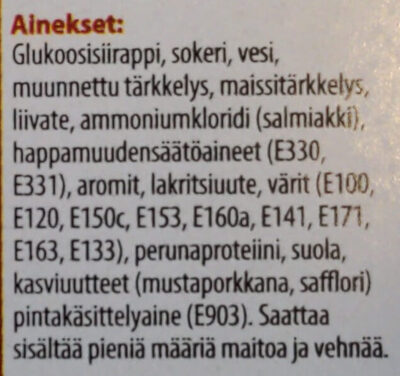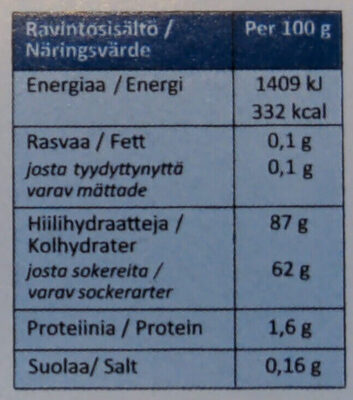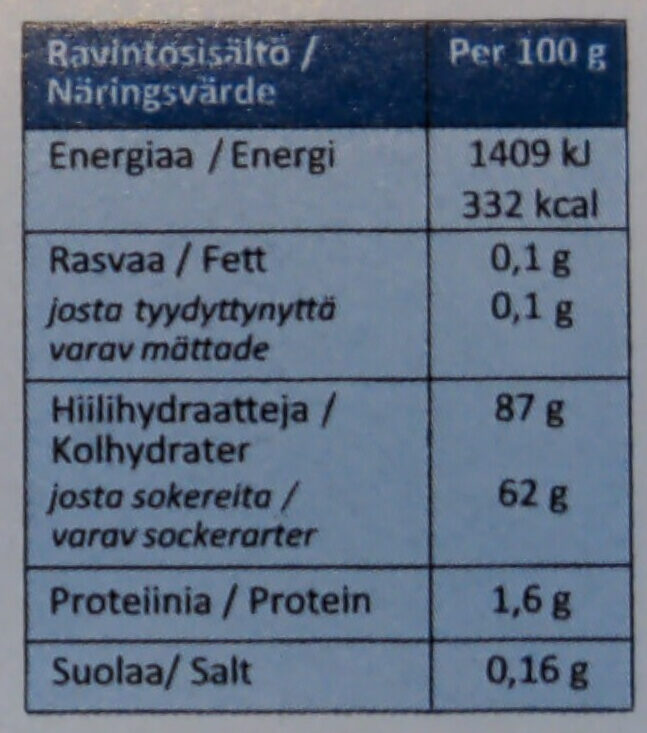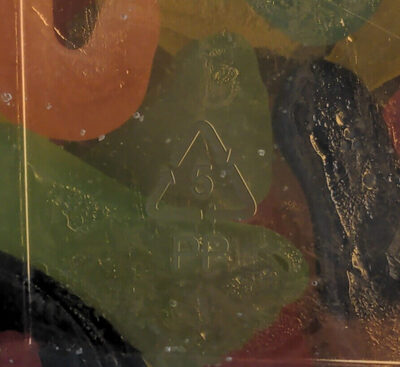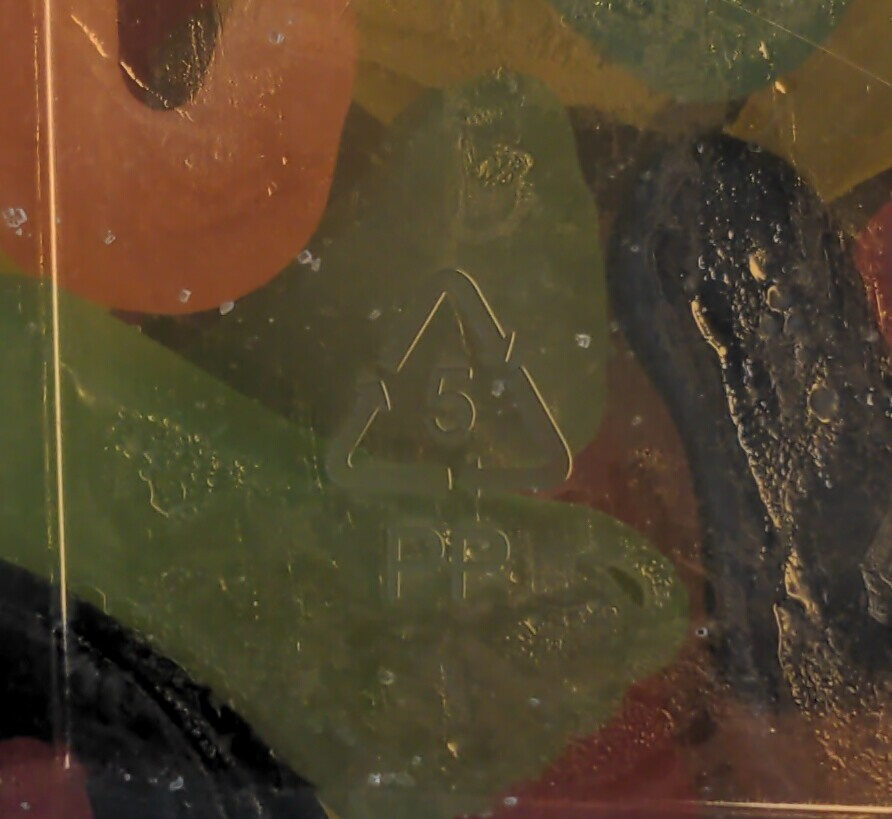Help us make food transparency the norm!
As a non-profit organization, we depend on your donations to continue informing consumers around the world about what they eat.
The food revolution starts with you!
Makeiskimara - Finlandia Candy - 1000 g
Makeiskimara - Finlandia Candy - 1000 g
This product page is not complete. You can help to complete it by editing it and adding more data from the photos we have, or by taking more photos using the app for Android or iPhone/iPad. Thank you!
×
Streckkod: 6410630003007 (EAN / EAN-13)
Vanligt namn: Hedelmän ja salmiakin makuinen makeissekoitus
Kvantitet: 1000 g
Förpackning: Plast, en:pp-polypropylene
Varumärken: Finlandia Candy
Kategorier: Snacks, Söta snacks, Konfekt, Godis
Tillverknings eller bearbetningsplats: Pajatie 5, 21870, Riihikoski, Suomi
Länk till produktsidan på producentens officiella webbplats: https://finlandiacandy.fi/makeisemme/mak...
Butiker: Prisma
Länder där såld: Finland
Matching with your preferences
Hälsa
Ingredienser
-
30 ingredienser
: Glukoosisiirappi, sokeri, vesi, muunnettu tärkkelys, maissitärkkelys, liivate, ammoniumkloridi (salmiakki), happamuudensäätöaineet (E330, E331), aromit, lakritsiuute, värit (E100, E120, E150c, E153, E160a, E141, E171, E163, E133), perunaproteiini, suola, kasviuutteet (mustaporkkana, safflori) pintakäsittelyaine (E903)Spår: Gluten, Mjölk
Food processing
-
Ultra processed foods
Elements that indicate the product is in the 4 - Ultra bearbetade livsmedel och drycker group:
- Tillsats: E100 - Kurkumin
- Tillsats: E120 - Karmin
- Tillsats: E133 - Briljantblått FCF
- Tillsats: E141 - E141 food additive
- Tillsats: E14XX - Modifierad stärkelse
- Tillsats: E150c - Ammoniakprocessen
- Tillsats: E153 - Vegetabiliskt kol
- Tillsats: E160a - Karoten
- Tillsats: E163 - Antocyaner
- Tillsats: E171 - Titandioxid
- Tillsats: E428 - Gelatin
- Tillsats: E903 - Karnaubavax
- Ingrediens: Färg
- Ingrediens: Arom
- Ingrediens: Ytbehandlingsmedel
- Ingrediens: Glukos
- Ingrediens: Glukossirap
Food products are classified into 4 groups according to their degree of processing:
- Obearbetade eller minimalt bearbetade livsmedel
- Bearbetade kulinariska ingredienser
- Halvfabrikat
- Ultra processed foods
The determination of the group is based on the category of the product and on the ingredients it contains.
Tillsatser
-
E120 - Karmin
Carminic acid: Carminic acid -C22H20O13- is a red glucosidal hydroxyanthrapurin that occurs naturally in some scale insects, such as the cochineal, Armenian cochineal, and Polish cochineal. The insects produce the acid as a deterrent to predators. An aluminum salt of carminic acid is the coloring agent in carmine. Synonyms are C.I. 75470 and C.I. Natural Red 4. The chemical structure of carminic acid consists of a core anthraquinone structure linked to a glucose sugar unit. Carminic acid was first synthesized in the laboratory by organic chemists in 1991.Källa: Wikipedia (Engelska)
-
E133 - Briljantblått FCF
Brilliant Blue FCF: Brilliant Blue FCF -Blue 1- is an organic compound classified as a triarylmethane dye and a blue azo dye, reflecting its chemical structure. Known under various commercial names, it is a colorant for foods and other substances. It is denoted by E number E133 and has a color index of 42090. It has the appearance of a blue powder. It is soluble in water, and the solution has a maximum absorption at about 628 nanometers.Källa: Wikipedia (Engelska)
-
E160a - Karoten
Carotene: The term carotene -also carotin, from the Latin carota, "carrot"- is used for many related unsaturated hydrocarbon substances having the formula C40Hx, which are synthesized by plants but in general cannot be made by animals -with the exception of some aphids and spider mites which acquired the synthesizing genes from fungi-. Carotenes are photosynthetic pigments important for photosynthesis. Carotenes contain no oxygen atoms. They absorb ultraviolet, violet, and blue light and scatter orange or red light, and -in low concentrations- yellow light. Carotenes are responsible for the orange colour of the carrot, for which this class of chemicals is named, and for the colours of many other fruits, vegetables and fungi -for example, sweet potatoes, chanterelle and orange cantaloupe melon-. Carotenes are also responsible for the orange -but not all of the yellow- colours in dry foliage. They also -in lower concentrations- impart the yellow coloration to milk-fat and butter. Omnivorous animal species which are relatively poor converters of coloured dietary carotenoids to colourless retinoids have yellowed-coloured body fat, as a result of the carotenoid retention from the vegetable portion of their diet. The typical yellow-coloured fat of humans and chickens is a result of fat storage of carotenes from their diets. Carotenes contribute to photosynthesis by transmitting the light energy they absorb to chlorophyll. They also protect plant tissues by helping to absorb the energy from singlet oxygen, an excited form of the oxygen molecule O2 which is formed during photosynthesis. β-Carotene is composed of two retinyl groups, and is broken down in the mucosa of the human small intestine by β-carotene 15‚15'-monooxygenase to retinal, a form of vitamin A. β-Carotene can be stored in the liver and body fat and converted to retinal as needed, thus making it a form of vitamin A for humans and some other mammals. The carotenes α-carotene and γ-carotene, due to their single retinyl group -β-ionone ring-, also have some vitamin A activity -though less than β-carotene-, as does the xanthophyll carotenoid β-cryptoxanthin. All other carotenoids, including lycopene, have no beta-ring and thus no vitamin A activity -although they may have antioxidant activity and thus biological activity in other ways-. Animal species differ greatly in their ability to convert retinyl -beta-ionone- containing carotenoids to retinals. Carnivores in general are poor converters of dietary ionone-containing carotenoids. Pure carnivores such as ferrets lack β-carotene 15‚15'-monooxygenase and cannot convert any carotenoids to retinals at all -resulting in carotenes not being a form of vitamin A for this species-; while cats can convert a trace of β-carotene to retinol, although the amount is totally insufficient for meeting their daily retinol needs.Källa: Wikipedia (Engelska)
-
E163 - Antocyaner
Anthocyanin: Anthocyanins -also anthocyans; from Greek: ἄνθος -anthos- "flower" and κυάνεος/κυανοῦς kyaneos/kyanous "dark blue"- are water-soluble vacuolar pigments that, depending on their pH, may appear red, purple, or blue. Food plants rich in anthocyanins include the blueberry, raspberry, black rice, and black soybean, among many others that are red, blue, purple, or black. Some of the colors of autumn leaves are derived from anthocyanins.Anthocyanins belong to a parent class of molecules called flavonoids synthesized via the phenylpropanoid pathway. They occur in all tissues of higher plants, including leaves, stems, roots, flowers, and fruits. Anthocyanins are derived from anthocyanidins by adding sugars. They are odorless and moderately astringent. Although approved to color foods and beverages in the European Union, anthocyanins are not approved for use as a food additive because they have not been verified as safe when used as food or supplement ingredients. There is no conclusive evidence anthocyanins have any effect on human biology or diseases.Källa: Wikipedia (Engelska)
-
E171 - Titandioxid
Titanium dioxide: Titanium dioxide, also known as titaniumIV oxide or titania, is the naturally occurring oxide of titanium, chemical formula TiO2. When used as a pigment, it is called titanium white, Pigment White 6 -PW6-, or CI 77891. Generally, it is sourced from ilmenite, rutile and anatase. It has a wide range of applications, including paint, sunscreen and food coloring. When used as a food coloring, it has E number E171. World production in 2014 exceeded 9 million metric tons. It has been estimated that titanium dioxide is used in two-thirds of all pigments, and the oxide has been valued at $13.2 billion.Källa: Wikipedia (Engelska)
-
E330 - Citronsyra
Citric acid: Citric acid is a weak organic acid that has the chemical formula C6H8O7. It occurs naturally in citrus fruits. In biochemistry, it is an intermediate in the citric acid cycle, which occurs in the metabolism of all aerobic organisms. More than a million tons of citric acid are manufactured every year. It is used widely as an acidifier, as a flavoring and chelating agent.A citrate is a derivative of citric acid; that is, the salts, esters, and the polyatomic anion found in solution. An example of the former, a salt is trisodium citrate; an ester is triethyl citrate. When part of a salt, the formula of the citrate ion is written as C6H5O3−7 or C3H5O-COO-3−3.Källa: Wikipedia (Engelska)
-
E331 - Natriumcitrater
Sodium citrate: Sodium citrate may refer to any of the sodium salts of citrate -though most commonly the third-: Monosodium citrate Disodium citrate Trisodium citrateThe three forms of the salt are collectively known by the E number E331. Sodium citrates are used as acidity regulators in food and drinks, and also as emulsifiers for oils. They enable cheeses to melt without becoming greasy.Källa: Wikipedia (Engelska)
-
E903 - Karnaubavax
Carnauba wax: Carnauba -; Portuguese: carnaúba [kaʁnɐˈubɐ]-, also called Brazil wax and palm wax, is a wax of the leaves of the palm Copernicia prunifera -Synonym: Copernicia cerifera-, a plant native to and grown only in the northeastern Brazilian states of Piauí, Ceará, Maranhão, Bahia, and Rio Grande do Norte. It is known as "queen of waxes" and in its pure state, usually comes in the form of hard yellow-brown flakes. It is obtained from the leaves of the carnauba palm by collecting and drying them, beating them to loosen the wax, then refining and bleaching the wax.Källa: Wikipedia (Engelska)
Ingrediensanalys
-
Kan innehålla palmolja
Ingredienser som kan innehålla palmolja: E160a
-
Icke-vegan
Non-vegan ingredients: E428, E120
-
Icke-vegetarisk
Non-vegetarian ingredients: E428, E120
-
Details of the analysis of the ingredients
: Glukoosisiirappi, sokeri, vesi, muunnettu tärkkelys, maissitärkkelys, liivate, ammoniumkloridi (salmiakki), happamuudensäätöaineet (e330, e331), aromit, lakritsiuute, värit (e100, e120, e150c, e153, e160a, e141, e171, e163, e133), perunaproteiini, suola, kasviuutteet (mustaporkkana, safflori), pintakäsittelyaine (e903)- Glukoosisiirappi -> en:glucose-syrup - vegan: yes - vegetarian: yes - ciqual_proxy_food_code: 31016 - percent_min: 6.66666666666667 - percent_max: 100
- sokeri -> en:sugar - vegan: yes - vegetarian: yes - ciqual_proxy_food_code: 31016 - percent_min: 0 - percent_max: 50
- vesi -> en:water - vegan: yes - vegetarian: yes - ciqual_food_code: 18066 - percent_min: 0 - percent_max: 33.3333333333333
- muunnettu tärkkelys -> en:modified-starch - vegan: yes - vegetarian: yes - ciqual_proxy_food_code: 9510 - percent_min: 0 - percent_max: 25
- maissitärkkelys -> en:corn-starch - vegan: yes - vegetarian: yes - ciqual_food_code: 9510 - percent_min: 0 - percent_max: 20
- liivate -> en:e428 - vegan: no - vegetarian: no - percent_min: 0 - percent_max: 16.6666666666667
- ammoniumkloridi -> en:e510 - vegan: yes - vegetarian: yes - percent_min: 0 - percent_max: 14.2857142857143
- salmiakki -> en:e510 - vegan: yes - vegetarian: yes - percent_min: 0 - percent_max: 14.2857142857143
- happamuudensäätöaineet -> en:acidity-regulator - percent_min: 0 - percent_max: 12.5
- e330 -> en:e330 - vegan: yes - vegetarian: yes - percent_min: 0 - percent_max: 12.5
- e331 -> en:e331 - vegan: yes - vegetarian: yes - percent_min: 0 - percent_max: 6.25
- aromit -> en:flavouring - vegan: maybe - vegetarian: maybe - percent_min: 0 - percent_max: 5
- lakritsiuute -> en:liquorice-extract - vegan: yes - vegetarian: yes - percent_min: 0 - percent_max: 5
- värit -> en:colour - percent_min: 0 - percent_max: 5
- e100 -> en:e100 - vegan: yes - vegetarian: yes - percent_min: 0 - percent_max: 5
- e120 -> en:e120 - vegan: no - vegetarian: no - percent_min: 0 - percent_max: 2.5
- e150c -> en:e150a - vegan: yes - vegetarian: yes - percent_min: 0 - percent_max: 1.66666666666667
- e153 -> en:e153 - vegan: yes - vegetarian: yes - percent_min: 0 - percent_max: 1.25
- e160a -> en:e160a - vegan: maybe - vegetarian: maybe - from_palm_oil: maybe - percent_min: 0 - percent_max: 1
- e141 -> en:e141 - vegan: yes - vegetarian: yes - percent_min: 0 - percent_max: 0.833333333333333
- e171 -> en:e171 - vegan: yes - vegetarian: yes - percent_min: 0 - percent_max: 0.714285714285714
- e163 -> en:e163 - vegan: yes - vegetarian: yes - percent_min: 0 - percent_max: 0.625
- e133 -> en:e133 - vegan: yes - vegetarian: yes - percent_min: 0 - percent_max: 0.555555555555556
- perunaproteiini -> en:potato-protein - vegan: yes - vegetarian: yes - percent_min: 0 - percent_max: 5
- suola -> en:salt - vegan: yes - vegetarian: yes - ciqual_food_code: 11058 - percent_min: 0 - percent_max: 0.16
- kasviuutteet -> en:plant-extracts - vegan: yes - vegetarian: yes - percent_min: 0 - percent_max: 0.16
- mustaporkkana -> en:black-carrot - vegan: yes - vegetarian: yes - ciqual_food_code: 20009 - percent_min: 0 - percent_max: 0.16
- safflori -> en:safflower - vegan: yes - vegetarian: yes - percent_min: 0 - percent_max: 0.16
- pintakäsittelyaine -> en:glazing-agent - percent_min: 0 - percent_max: 0.16
- e903 -> en:e903 - vegan: yes - vegetarian: yes - percent_min: 0 - percent_max: 0.16
Näring
-
Poor nutritional quality
⚠ ️Varning: mängden fibrer är inte angiven, eventuella positiv inverkan på betyget kunde inte beaktas.⚠ ️Warning: the amount of fruits, vegetables and nuts is not specified on the label, it was estimated from the list of ingredients: 0This product is not considered a beverage for the calculation of the Nutri-Score.
Positiva poäng: 0
- Proteiner: 0 / 5 (värde: 1.6, avrundat värde: 1.6)
- Fiber: 0 / 5 (värde: 0, avrundat värde: 0)
- Frukt, grönsaker, nötter och raps- / valnöt- / olivoljor: 0 / 5 (värde: 0.0028483072916643, avrundat värde: 0)
Negativa poäng: 14
- Energi: 4 / 10 (värde: 1409, avrundat värde: 1409)
- Socker: 10 / 10 (värde: 62, avrundat värde: 62)
- Mättat fett: 0 / 10 (värde: 0.1, avrundat värde: 0.1)
- Natrium: 0 / 10 (värde: 64, avrundat värde: 64)
The points for proteins are not counted because the negative points are greater or equal to 11.
Näringsvärde: (14 - 0)
Nutri-Score:
-
Näringsvärden
-
Fett i låg kvantitet (0.1%)
What you need to know- A high consumption of fat, especially saturated fats, can raise cholesterol, which increases the risk of heart diseases.
Recommendation: Limit the consumption of fat and saturated fat- Choose products with lower fat and saturated fat content.
-
Mättat fett i låg kvantitet (0.1%)
What you need to know- A high consumption of fat, especially saturated fats, can raise cholesterol, which increases the risk of heart diseases.
Recommendation: Limit the consumption of fat and saturated fat- Choose products with lower fat and saturated fat content.
-
Sockerarter i hög kvantitet (62%)
What you need to know- A high consumption of sugar can cause weight gain and tooth decay. It also augments the risk of type 2 diabetes and cardio-vascular diseases.
Recommendation: Limit the consumption of sugar and sugary drinks- Sugary drinks (such as sodas, fruit beverages, and fruit juices and nectars) should be limited as much as possible (no more than 1 glass a day).
- Choose products with lower sugar content and reduce the consumption of products with added sugars.
-
Salt i låg kvantitet (0.16%)
What you need to know- A high consumption of salt (or sodium) can cause raised blood pressure, which can increase the risk of heart disease and stroke.
- Many people who have high blood pressure do not know it, as there are often no symptoms.
- Most people consume too much salt (on average 9 to 12 grams per day), around twice the recommended maximum level of intake.
Recommendation: Limit the consumption of salt and salted food- Reduce the quantity of salt used when cooking, and don't salt again at the table.
- Limit the consumption of salty snacks and choose products with lower salt content.
-
-
Näringsfakta
Näringsfakta Som såld
för 100 g / 100 mlCompared to: Godis Energi 1 409 kj
(332 kcal)−3 % Fett 0,1 g −94 % Mättat fett 0,1 g −90 % Kolhydrat 87 g +8 % Sockerarter 62 g +15 % Fiber ? Protein 1,6 g −37 % Salt 0,16 g −30 % Fruits‚ vegetables‚ nuts and rapeseed‚ walnut and olive oils (estimate from ingredients list analysis) 0,003 %
Miljö
-
Eco-Score C - Måttlig miljöpåverkan
The Eco-Score is an experimental score that summarizes the environmental impacts of food products.→ The Eco-Score was initially developped for France and it is being extended to other European countries. The Eco-Score formula is subject to change as it is regularly improved to make it more precise and better suited to each country.Life cycle analysis
-
Average impact of products of the same category: B (Score: 62/100)
Kategori: Candies, all types
Kategori: Candies, all types
- PEF environmental score: 0.41 (the lower the score, the lower the impact)
- including impact on climate change: 1.73 kg CO2 eq/kg of product
Stage Impact Jordbruk
78.2 %Bearbetar
10.7 %Förpackning
5.5 %Transportation
4.5 %Distribution
1.1 %Consumption
0.0 %
Bonuses and maluses
-
Missing origins of ingredients information
Malus: -5
⚠ ️ The origins of the ingredients of this product are not indicated.
If they are indicated on the packaging, you can modify the product sheet and add them.
If you are the manufacturer of this product, you can send us the information with our free platform for producers.
-
Packaging with a medium impact
Malus: -8
Form Material Återvinning Impact Okänd PP 5 - polypropen Hög ⚠ ️ The information about the packaging of this product is not sufficiently precise (exact shapes and materials of all components of the packaging).⚠ ️ For a more precise calculation of the Eco-Score, you can modify the product page and add them.
If you are the manufacturer of this product, you can send us the information with our free platform for producers.
Eco-Score for this product
-
Impact for this product: C (Score: 49/100)
Produkt: Makeiskimara - Finlandia Candy - 1000 g
Life cycle analysis score: 62
Sum of bonuses and maluses: -13
Final score: 49/100
-
Carbon footprint
-
Equal to driving 0.9 km in a petrol car
173 g CO² per 100g of product
The carbon emission figure comes from ADEME's Agribalyse database, for the category: Candies, all types (Source: ADEME Agribalyse Database)
Stage Impact Jordbruk
52.3 %Bearbetar
19.5 %Förpackning
15.7 %Transportation
11.6 %Distribution
1.0 %Consumption
0.0 %
Förpackning
-
Packaging with a medium impact
-
Packaging parts
(PP 5 - polypropen)
-
Packaging materials
Material % Packaging weight Packaging weight per 100 g of product Plast
-
Transportation
-
Origins of ingredients
Missing origins of ingredients information
⚠ ️ The origins of the ingredients of this product are not indicated.
If they are indicated on the packaging, you can modify the product sheet and add them.
If you are the manufacturer of this product, you can send us the information with our free platform for producers.Add the origins of ingredients for this product Add the origins of ingredients for this product
Report a problem
-
Incomplete or incorrect information?
Category, labels, ingredients, allergens, nutritional information, photos etc.
If the information does not match the information on the packaging, please complete or correct it. Open Food Facts is a collaborative database, and every contribution is useful for all.
Datakällor
Produkt tillagd den av mvainola
Senast ändrad produktsida på av mvainola.
Produktsida också redigerad av openfoodfacts-contributors, roboto-app.


